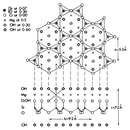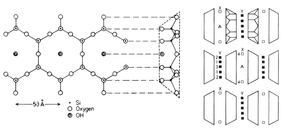
Browsing Toxins
| T3DB ID | Name CAS Number | Formula Weight | Structure | Type | Mechanism of Toxicity |
|---|---|---|---|---|---|
| T3D0115 | alpha-Hexachlorocyclohexane 319-84-6 | C6H6Cl6 290.830 g/mol |  |
| Hexachlorocyclohexane is a neurotoxin that interferes with GABA neurotransmitter function by interacting with the GABA-A receptor-chloride channel complex at the picro...more Number of Targets: 42 |
| T3D0116 | 1,2,3-Trichlorobenzene 87-61-6 | C6H3Cl3 181.447 g/mol |  |
| Trichlorobenzene may uncouple mitochondrial oxidative phosphorylation, inducing potassium ion release and inhibiting respiratory control. It's metabolites may covalent...more Number of Targets: 42 |
| T3D0117 | Manganese 7439-96-5 | Mn 54.937 g/mol |  |
| Manganese is a cellular toxicant that can impair transport systems, enzyme activities, and receptor functions. It primarily targets the central nervous system, particu...more Number of Targets: 10 |
| T3D0119 | Chrysotile asbestos 12001-29-5 | Mg3Si2O5(OH)4 Not Available |  |
| When asbestos fibers are inhaled, many are deposited on the epithelial surface of the respiratory tree. Fibers that are retained in the lung or mesothelium for long pe...more Number of Targets: 1 |
| T3D0120 | Strontium-90 10098-97-2 | Sr 89.908 g/mol |  |
| The fact that strontium is chemically similar to calcium allows it to exchange for calcium in bone. It affects bone development and strength by binding directly to hyd...more Number of Targets: 1 |
| T3D0121 | Plutonium-239 15117-48-3 | Pu 239.052 g/mol |  |
| The alpha radiation plutonium emits does not penetrate the skin but can irradiate internal organs when plutonium is inhaled or ingested. Particularly at risk are the s...more Number of Targets: 1 |
| T3D0122 | Polonium-210 13981-52-7 | Po 209.983 g/mol |  |
| The alpha radiation polonium emits does not penetrate the skin but can irradiate internal organs when polonium is inhaled or ingested. The ionizing radiation produced ...more Number of Targets: 1 |
| T3D0123 | Methylmercury 22967-92-6 | CH3Hg 215.620 g/mol |  |
| Methylmercury is neurotoxic. It potently affects the release of neurotransmitter from presynaptic nerve terminals. Methylmercury alters calcium ion concentrations by a...more Number of Targets: 70 |
| T3D0124 | Plutonium-238 13981-16-3 | Pu 238.050 g/mol |  |
| The alpha radiation plutonium emits does not penetrate the skin but can irradiate internal organs when plutonium is inhaled or ingested. Particularly at risk are the s...more Number of Targets: 1 |
| T3D0125 | Lead-210 14255-04-0 | Pb 209.984 g/mol |  |
| Lead mimics other biologically important metals, such as zinc, calcium, and iron, competing as cofactors for many of their respective enzymatic reactions. For example,...more Number of Targets: 30 |
| T3D0126 | Plutonium 7440-07-5 | Pu 244.000 g/mol |  |
| The alpha radiation plutonium emits does not penetrate the skin but can irradiate internal organs when plutonium is inhaled or ingested. Particularly at risk are the s...more Number of Targets: 1 |
| T3D0127 | Chlorpyrifos 2921-88-2 | C9H11Cl3NO3PS 350.586 g/mol |  |
| Chlorpyrifos is a cholinesterase or acetylcholinesterase (AChE) inhibitor. A cholinesterase inhibitor (or 'anticholinesterase') suppresses the action of acetylcholines...more Number of Targets: 55 |
| T3D0128 | Copper 7440-50-8 | Cu 63.545 g/mol |  |
| Excess copper is sequestered within hepatocyte lysosomes, where it is complexed with metallothionein. Copper hepatotoxicity is believed to occur when the lysosomes bec...more Number of Targets: 20 |
| T3D0129 | Americium-241 86954-36-1 | Am 241.057 g/mol |  |
| Americium toxicity results primarily from the damage done by the alpha particle emitted during radioactive decay. This alpha particle has very limited penetration in t...more Number of Targets: 1 |
| T3D0130 | Radon-220 22481-48-7 | Rn 220.011 g/mol |  |
| The ionizing radiation produced by radon causes cellular damage that includes DNA breakage, accurate or inaccurate repair, apoptosis, gene mutations, chromosomal chang...more Number of Targets: 1 |
| T3D0131 | Amosite asbestos 12172-73-5 | (Na, K)0-1(Fe2+, Mg)2(Fe2+, Mg)5Si8O22(OH)2, approx. Fe2+5Mg2 Not Available |  |
| When asbestos fibers are inhaled, many are deposited on the epithelial surface of the respiratory tree. Fibers that are retained in the lung or mesothelium for long pe...more Number of Targets: 1 |
| T3D0132 | Iodine-131 10043-66-0 | I 130.906 g/mol |  |
| Iodide inhibits adenylate cyclase in thyroid gland follicle cells and decreases the TSH-induced rise in intracellular cAMP. This results in decreased iodination of thy...more Number of Targets: 11 |
| T3D0133 | Hydrogen cyanide 74-90-8 | CHN 27.025 g/mol |  |
| Organic nitriles decompose into cyanide ions both in vivo and in vitro. Consequently the primary mechanism of toxicity for organic nitriles is their production of toxi...more Number of Targets: 44 |
| T3D0134 | Tributyltin 688-73-3 | C12H28Sn 291.060 g/mol |  |
| Organotin compounds produce neurotoxic and immunotoxic effects. Organotins may directly activate glial cells contributing to neuronal cell degeneration by local releas...more Number of Targets: 19 |
| T3D0135 | Guthion 86-50-0 | C10H12N3O3PS2 317.324 g/mol |  |
| Guthion is a cholinesterase or acetylcholinesterase (AChE) inhibitor. A cholinesterase inhibitor (or 'anticholinesterase') suppresses the action of acetylcholinesteras...more Number of Targets: 14 |
| T3D0136 | Neptunium-237 13994-20-2 | Np 237.048 g/mol |  |
| The ionizing radiation produced by neptunium causes cellular damage that includes DNA breakage, accurate or inaccurate repair, apoptosis, gene mutations, chromosomal c...more Number of Targets: 1 |
| T3D0137 | Chrysene 218-01-9 | C18H12 228.288 g/mol |  |
| The ability of PAH's to bind to blood proteins such as albumin allows them to be transported throughout the body. Many PAH's induce the expression of cytochrome P450 e...more Number of Targets: 5 |
| T3D0138 | Chlordecone 143-50-0 | C10Cl10O 490.636 g/mol |  |
| It is believed that the α-noradrenergic and serotonergic transmitter systems in the central nervous system are the primary neurotransmitter systems affected by chlorde...more Number of Targets: 55 |
| T3D0139 | Iodine-129 15046-84-1 | I 128.905 g/mol |  |
| Iodide inhibits adenylate cyclase in thyroid gland follicle cells and decreases the TSH-induced rise in intracellular cAMP. This results in decreased iodination of thy...more Number of Targets: 11 |
| T3D0140 | Plutonium-240 14119-33-6 | Pu 240.054 g/mol |  |
| The alpha radiation plutonium emits does not penetrate the skin but can irradiate internal organs when plutonium is inhaled or ingested. Particularly at risk are the s...more Number of Targets: 1 |